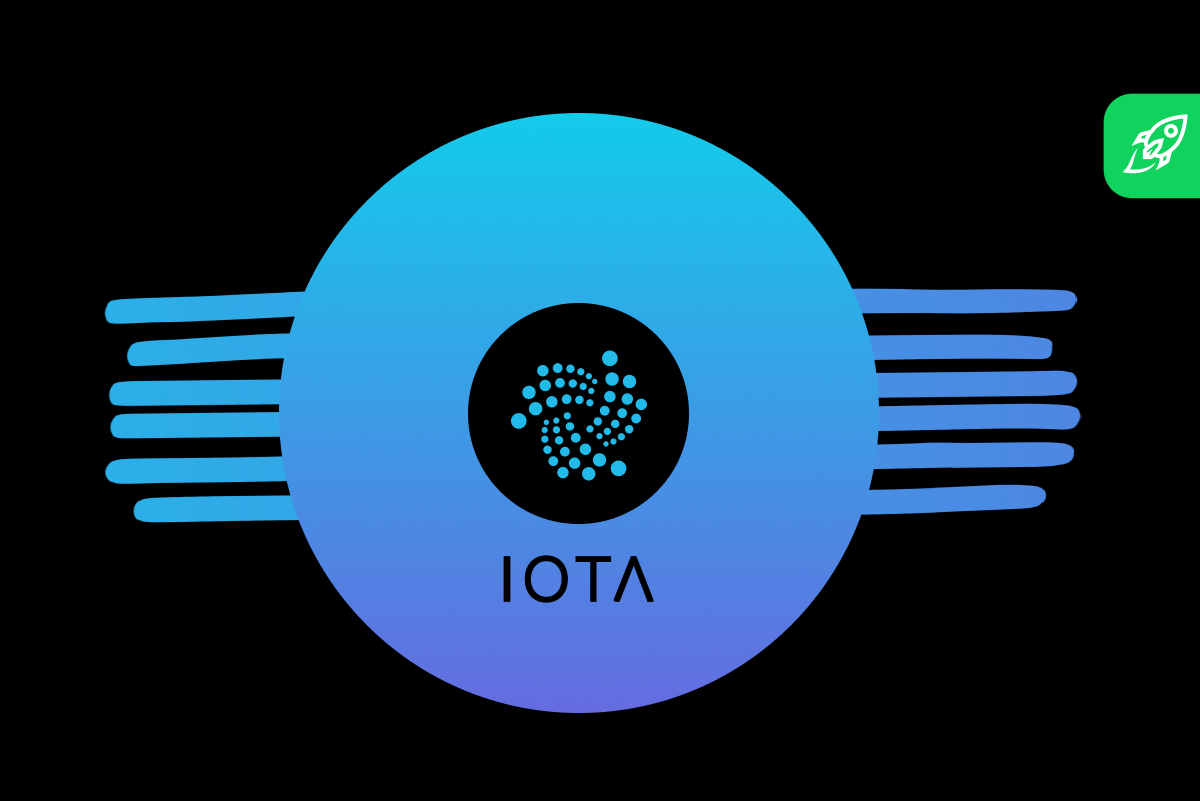Having appeared on exchanges, the IOTA distributed ledger has been firmly established among the TOP-10 cryptocurrencies by market capitalization since the first days, attracting everyone’s attention. What is IOTA? What are the peculiarities of IOTA’s new data structure solution? Let’s figure it out.
IOTA Definition
The abbreviation IOTA stands for the Internet Of Things (IoT). The name itself stores the purpose of this cryptocurrency.
The Internet of Things (IoT) is a globally distributed network that includes various devices (“things”) connected to the World Wide Web. Being connected to control processing and storage centers, all these devices are equipped with sensors and internal information transmission networks. IOTA aims to provide limitless throughput at minimal expense. IOTA’s network goal is to bring all the digital devices together through smart cities, digital identity, and global trade, creating a seamless network of machines that makes our lives much easier.
The IOTA cryptocurrency is designed so that devices connected to the IoT are able to make automatic payments according to specified rules. All this is created to automate the software system.
For example, you have a “smart” refrigerator, but it has run out of products: the refrigerator automatically sends a purchase request, and the products are also “delivered” by drones without human intervention. Does that sound unrealistic? Many crypto experts argue that the future belongs to such systems.
IOTA is a non-standard cryptocurrency, and instead of blockchain it uses Tangle — a highly scalable distributed ledger technology. IOTA’s Tangle is a parallel system based on a directed acyclic graph (DAG), in which transactions can be processed simultaneously rather than sequentially. While it doesn’t use blockchain, its distributed ledger is completely decentralized and free from the influence of any central authority.
How Does IOTA Work and What Technology Is Behind It?
From a technical point of view, three aspects of the IOTA decentralized system are particularly worth outlining:
1. Tangle. IOTA distributed ledger does not use blockchain like most of the digital currencies do today. Instead, a DAG, which is called Tangle, is used. DAG is essentially a generalization of the Blockchain protocol.
2. Transactions. In order to create a new payment in the IOTA network, the user’s device must first confirm two previous transactions. If the transaction is certified by a certain number of random new payments, then it can be considered confirmed by the entire network.
3. Encryption. Cryptographic signatures used in the system are based not on the elliptical method, as in most cryptocurrencies, but on Winternitz, which allows transactions’ processing to become more efficient and secure. IOTA’s founders have developed their own hash function called Curl. However, it was criticized because of a possible vulnerability, so in August 2017 it was replaced with a new feature Kerl, where this vulnerability is missing.
The essence of Tangle’s work is as follows — to make a transaction, you need to confirm two previous ones by a third party inside of the system. This condition is necessary for the network to function correctly and safely. If it finds any single point of failure when checking a financial transaction, the IOTA protocol immediately suspends it.
A similar algorithm of actions occurs every time a new transaction takes place in the network, which, in turn, creates a new block in the chain and approves itself when confirming two other transactions made before it.
Such a system, in fact, makes each user a full-fledged miner who serves the network, allowing it to function properly. The only difference is that you do not receive a reward for opening a new block but have an opportunity to transfer MIOTA coins for free without any charges.
This technology was created by IOTA developers as an alternative to the well-known blockchain. Being a new technology, Tangle is not yet fully recognized by users in the world of cryptocurrencies. However, at the same time, it has an undoubted plus — the network can withstand a huge number of simultaneous transactions, while the blockchain will be constantly overloaded.
Another advantage is the ability to conduct a transaction without the need to be fully connected to the global IOTA network, which is also impossible in the blockchain. However, Tangle also has a disadvantage — hackers can arrange a 51% attack or a double-spending attack on the network using more powerful equipment than other users of the system.
In general, the unique Tangle technology is the main competitor of the blockchain, which has both its pros and cons.
If you want to buy IOTA tokens, there are just several options available. Unfortunately, it is impossible to buy or exchange MIOTA at instant cryptocurrency exchanges, including Changelly. However, you can use our service for a fast and smooth purchase of more than two hundred digital assets available at the Changelly platform.
Pros and Cons of IOTA
The main advantages of the IOTA cryptocurrency include the lack of high transactional costs, increased speed of transactions, as well as the ability to execute microtransactions. All of the above becomes possible thanks to Tangle. Many crypto enthusiasts have already named it “Blockchain 3.0”, although in fact blocks are not created in it, therefore it cannot be seriously called a blockchain.
At the moment, there are two opinions about IOTA. It is clear that the potential of the platform is huge, but there have not been any real examples of its application. Nevertheless, the project cooperates with many economic giants and financial institutions, which in itself gives a score in its favor. The disadvantages relate to the level of security. The lack of full node miners leads to a 51% probability of an attack, and the lack of a full-fledged hardware wallet for storing IOTA tokens forces users to turn to third-party services that are not always safe.
As noted above, the developers of IOTA decided to outline a number of problematic issues specific to the Bitcoin network, which are solved in the IOTA project. We will discuss them in more detail below so that you can understand what are the main distinguishing features of the new currency.
Centralization of cryptocurrency mining. It is known that in order to get more coins, miners try to join pools. However, this speeds up the centralization process and makes the network more vulnerable to hackers. This is not possible in IoT technology. Old cryptographic technologies. With the advent of new platforms based on the latest developments in the field of cryptography, the idea of Bitcoin is becoming less relevant. It is more of a prototype for further progress.
The complexity of microtransactions. As mentioned above, high transactional fees are unacceptable for the Internet of Things.
The impossibility of separation. Many decentralized currencies cannot function when any part of the system is separated. It is also difficult to separate a part of the network at will.
Discriminatory policy. Classic cryptocurrencies are homogeneous systems where the role of each participant is clearly visible. This often creates conflict situations by forcing blockchain users to spend their own resources on localizing conflicts and resolving them.
The established scalability limit. As you know, most digital money has certain restrictions on the transaction’s maximum speed. And most importantly, these limitations cannot be set in the IOTA ecosystem due to the decentralized nature of the system with distributed ledger technologies.
Demands for hardware. Bitcoin and its descendants use their own unique scenario, which is based on the Proof-of-Work (PoW) method. Other currencies use Proof-of-Stake (PoS). Due to the complexity of these methods, the requirements for devices that ensure their operation have increased significantly.
What Is Wrong with the IOTA Network?
Let’s consider the critical problems of the platform, which Nick Johnson, the developer of the Ethereum Foundation, outlined in his post on September 26:
Unconvincing justification for using ternary code in IOTA protocol.
IOTA is built on existing hardware that uses only binary code, as well as data transmission networks. As a result, all the internal ternary values (trits) will have to be recoded into binary code, requiring additional capacity for data storage and calculations.
IOTA neglects the basic postulates of cryptography.
This point largely arises from the previous one: the choice of the ternary code required “reinventing” basic operations, such as cryptographic hashing, which violates rule No. 1 of cryptography — not to create new cryptographic algorithms unnecessarily. This approach led to quite a predictable result highlighted by a group of researchers: there were discovered serious vulnerabilities in the Curl hash function used in IOTA.
As a result, IOTA was rewritten from the ground up for a network update called Chrysalis, or IOTA 1.5, which launched on April 28, 2021. In this update, controversial decisions such as ternary encoding and quantum-proof cryptography were left behind and replaced with established standards.
IOTA does not follow the established practice of open-source projects.
IOTA’s co-founder Sergey Ivancheglo states that the vulnerabilities in the Curl hash function were left intentionally, thus becoming a kind of “copy protection”: if IOTA clones appeared, the team could publish these vulnerabilities. This is a manifestation of real hostility to the community of open-source projects: it’s like publishing a recipe for a dish without a key ingredient so that whoever tries to cook a dish according to the recipe gets poisoned.
IOTA data integrity guarantees are insufficient.
Instead of blockchain, IOTA uses Tangle — directed acyclic graph of transactions, without a single header for all.
Each transaction is confirmed using the PoW consensus; however, this algorithm has constant complexity. Since IOTA must work on low-power nodes, the complexity of the algorithm is small, so it will not be difficult for specialized equipment to suppress all the processing power of the Tangle graph. In addition, unlike blockchain systems such as Bitcoin or Ethereum, its complexity is not adaptive.
This means that the security of Tangle directly depends on the number of transactions being processed, and there is no possibility to adapt the security level to real-world conditions. The reliability of the blockchain is ensured by the presence of financial rewards for miners based on game theory solutions and guarantees that an attacker should have more hash power than all the bonafide participants combined. There is no evidence of such guarantees in the IOTA system.
FAQ
What does IOTA Crypto stand for?
IOTA is a distributed ledger designed to record and execute transactions between machines and devices in the Internet of Things (IoT) ecosystem.
Is IOTA Tangle secure?
IOTA uses a non-sequential distributed ledger: once a transaction has been verified, it’s impossible for the system or any external interference to roll the progress back and make any changes. Apart from that, the network uses cryptographic encryption for all the activity and interaction to discourage interference and keep your data and information as secure as possible.




